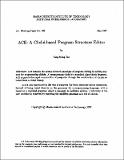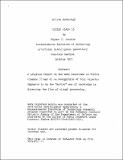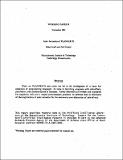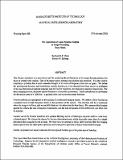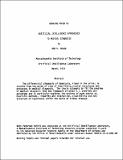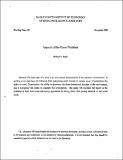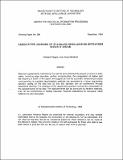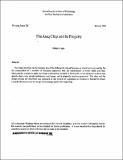Browsing AI Working Papers (1971 - 1995) by Title
Now showing items 1-20 of 291
-
ACE: A Cliché-based Program Structure Editor
(MIT Artificial Intelligence Laboratory, 1987-05)ACE extends the syntax-directed paradigm of program editing by adding support for programming clichés. A programming cliché is a standard algorithmic fragment. ACE supports the rapid construction of programs through the ... -
Active Knowledge
(MIT Artificial Intelligence Laboratory, 1973-10)A progress report on the work described in Vision Flashes 33 and 43 on recognition of real objects. Emphasis is on the "active" use of knowledge in directing the flow of visual processing. -
Actor Semantics of PLANNER-73
(MIT Artificial Intelligence Laboratory, 1974-11)Work on PLANNER-73 and actors has led to the development of a basis for semantics of programming languages. Its value in describing programs with side-effects, parallelism, and synchronization is discussed. Formal definitions ... -
An Actor-Based Computer Animation Language
(MIT Artificial Intelligence Laboratory, 1976-02)This paper reproduces an appendix of a doctoral thesis proposal that describes a language based on actor semantics designed especially for animation. The system described herein is built upon MacLisp and is also compatible ... -
Advice on the Fast-paced World of Electronics
(MIT Artificial Intelligence Laboratory, 1974-05)This paper is a reprint of a sketch of an electronic-circuit-designing program, submitted a a Ph.D. proposal. It describes the electronic design problem with respect to the classic trade-off between expertise and generality. ... -
AI Lab Faculty
(MIT Artificial Intelligence Laboratory, 1992-09)This document is meant to introduce new graduate students in the MIT AI Lab to the faculty members of the laboratory and their research interests. Each entry consists of the faculty member's picture, if available, some ... -
AMORD: A Deductive Procedure System
(MIT Artificial Intelligence Laboratory, 1977-08)We have implemented an interpreter for a rule-based system, AMORD, based on a non-chronological control structure and a system of automatically maintained data-dependencies. The purpose of this paper is tutorial. We wish ... -
Analsysis by Propagation of Constraints in Elementary Geometry Problem Solving
(MIT Artificial Intelligence Laboratory, 1976-06)This paper describes GEL, a new geometry theorem prover. GEL is the result of an attempt to transfer the problem solving abilities of the EL electronic circuit analysis program of Sussman and Stallman to the domain of ... -
Analyzing the State Behavior of Programs
(MIT Artificial Intelligence Laboratory, 1988-08)It is generally agreed that the unrestricted use of state can make a program hard to understand, hard to compile, and hard to execute, and that these difficulties increase in the presence of parallel hardware. This problem ... -
Another Approach to English
(MIT Artificial Intelligence Laboratory, 1974-06)A new approach to building descriptions of English is outlined and programs implementing the ideas for sentence-sized fragments are demonstrated. -
Application of Data Flow Computation to the Shaded Image Problem
(MIT Artificial Intelligence Laboratory, 1978-05)This paper presents a method of producing shaded images of terrain at an extremely fast rate by exploiting parallelism. The architecture of the Data Flow Computer is explained along with an appropriate "program" to compute ... -
An Application of Line-labeling and other Scene-analysis Techniques to the Problem of Hidden-line Removal
(MIT Artificial Intelligence Laboratory, 1974-03)The problem of hidden-line drawings of scenes composed of opaque polyhedra is considered. The use of Huffnan labeling is suggested as a method if simplifying the task and increasing its intuitive appeal. The relation between ... -
The Application of Linear Systems Analysis to Image Processing. Some Notes.
(MIT Artificial Intelligence Laboratory, 1974)The Fourier transform is a convenient tool for analyzing the performance of an image-forming system, but must be treated with caution. One of its major uses is turning convolutions into products. It is also used to transform ... -
Applications of Circular Array Sensors
(MIT Artificial Intelligence Laboratory, 1980-04)The application of the Reticon RO-64 annular photo-diode array to the task of optical tracking of special targets, direct optical focusing, and automatic printed circuit board inspection were studied. In order to facilitate ... -
An Approach to Three-Dimensional Decomposition and Description of Polyhedra
(MIT Artificial Intelligence Laboratory, 1972-07)This paper presents a description methodology for trihedral planar solids that, as in Roberts' approach, decomposes an object into simpler components. The present approach, however, is more sophisticated and results in a ... -
Artificial Intelligence Approaches to Medical Diagnosis
(MIT Artificial Intelligence Laboratory, 1974-03)The differential diagnosis of hematuria, blood in the urine, is studied from the point of view of identifying crucial structures and processes in medical diagnosis. The thesis attempts to fit the problem of medical diagnosis ... -
Aspects of the Rover Problem
(MIT Artificial Intelligence Laboratory, 1982-12)The basic task of a rover is to move about automonously in an unknown environment. A working rover must have the following three subsystems which interact in various ways: 1) locomotion--the ability to move, 2) perception--the ... -
Assigning Hierarchical Descriptions to Visual Assemblies of Blocks with Occlusion
(MIT Artificial Intelligence Laboratory, 1975-10)This memo describes a program for parsing simple two-dimensional piles of blocks into plausible nested subassemblies. Each subassembly must be one of a few types known to the program, such as stack, tower, or arch. Each ... -
Associative Learning of Standard Regularizing Operators in Early Vision
(MIT Artificial Intelligence Laboratory, 1984-12)Standard regularization methods can be used to solve satisfactorily several problems in early vision, including edge detection, surface reconstruction, the computation of motion and the recovery of color. In this paper, ... -
The Assq Chip and Its Progeny
(MIT Artificial Intelligence Laboratory, 1982-01)The Assq Chip lives on the memory bus of the Scheme-81 chip of Sussman et al and serves as a utility for the computation of a number of functions concerned with the maintenance of linear tables and lists. Motivated by a ...

